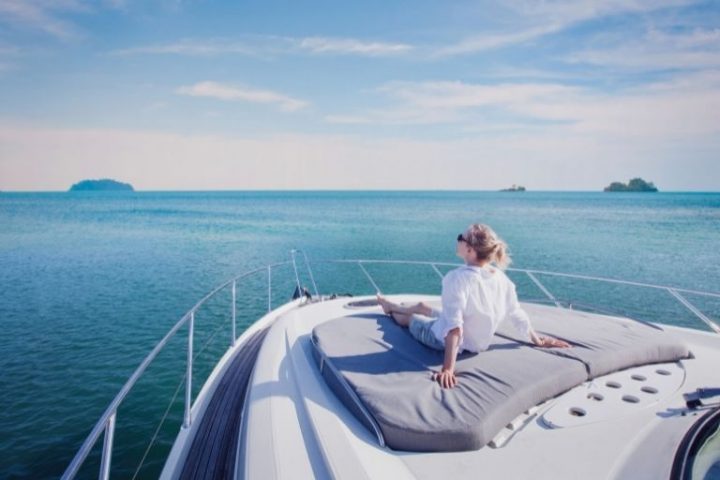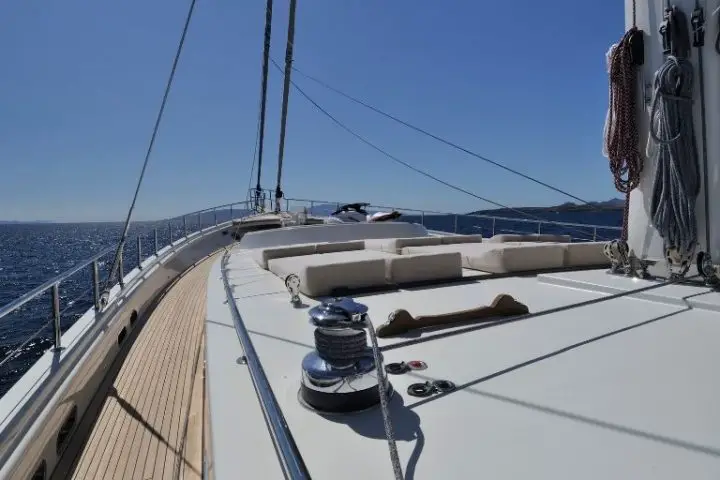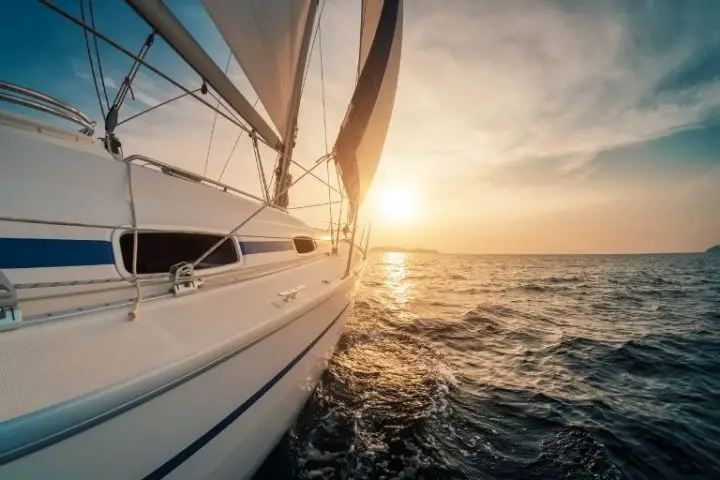A bluewater sailboat is designed from the keel up to cross oceans. Of the many thousands of sailboats manufactured every year worldwide, only a few meet this definition.
Before diving into the best examples, let’s take a moment to think about what really counts as a bluewater sailboat and what criteria you might use to evaluate different designs.
Table of Contents
- What Does Bluewater Sailboat Mean?
- Criteria for Picking Your Bluewater Boat
- 10 Best Offshore Bluewater Sailboats
- Final Thoughts
What Does Bluewater Sailboat Mean?
When searching for boats online, the term “bluewater” gets batted around quite a bit. “Bluewater” refers to that mythical color that the ocean takes on when you are far offshore. The sunlight illuminates only the first hundred feet or so, and the endless abyss beneath gives that color an other-worldly quality.
The implication is that a “bluewater sailboat” is capable of seeing those blue waters. It’s capable of venturing offshore, and it’s capable of the self-sufficiency required to survive out there.
But there are still many questions to be answered. For every sort of bluewater expedition that you could dream up, you can find a type of sailboat that was built to do it.
A better and more descriptive term for the type of boat is a passage-making sailboat. This is a sailboat built to cross oceans. Most people want to do this in a sailboat between 40 and 65 feet long, all in all. Larger yachts are, more or less by definition, bluewater boats.
The distinction lies in the company that these mid-sized ocean-going vessels keep. There have been many thousands of sailboats ranging from 40 to 65 feet sold all over the world. But a vast majority of these designs were not built with ocean voyaging as their primary purpose.
Instead, many can be described as coastal cruisers—built for protected waters or maybe even carefully planned hops across sections of big water. Others were designed as charter boats that can provide luxurious accommodations for a week-long island vacation.
By and large, other priorities shine through that detract from their sea-kindliness and passage-making abilities on these boats. Manufacturers may choose to use hull shapes that provide bountiful interior and living space, making the ride rougher in rough seas.
They may choose a fin keel and spade rudder for better upwind performance and more overall speed, knowing that these designs are less sturdy and more prone to damage than a full-keel bluewater cruiser. They may include large windows, which add lovely light to the living space but also pose a danger should they be breached offshore in storm conditions.
Many boats like this have completed long passages or even circumnavigated successfully. To say that it wasn’t designed for the journey isn’t to say that it isn’t possible to make the journey. But they still should not be considered “bluewater sailboats” because they have done it and gotten lucky—or have done it carefully and been heavily modified to do it safely.

Criteria for Picking Your Bluewater Boat
Everyone has a different vision for what they want from a bluewater sailboat. The term carries a lot of baggage. There are traditional heavily-built cruisers that can weather anything. And then, there are the well-equipped and upgraded production boats that can get the job done.
For our article, we will look at the first option—boats designed and built with voyaging across oceans in mind. Unfortunately, the list isn’t long and is full of older boat designs. This is mainly because this type of boat has fallen out of style, replaced by production boats that emphasize living accommodations and crew comfort while in port.
In the end, the bluewater boat you pick shows your priorities. Of course, no boat is perfect, and every sailor makes some sacrifices. Here are a few of the things that seasoned bluewater sailors will be looking for in an offshore-bound vessel.
Hull Shape and Design
The hull design of a boat affects many things about its performance, but most critically, it affects its ride and comfort at sea. This is especially true going upwind. Modern production boats are almost uniformly flat bottomed, which can pound dreadfully in a heavy seaway.
On the other hand, classic full-keel designs are renowned for their easy motions at sea. They are commonly described as slow compared to modern designs. But truthfully, all sailboats are slow. Would you rather have a comfortable boat that cruises at 7 knots or lose your teeth while doing 9 knots?
Strong Construction
Conditions offshore can deteriorate with horrifying speed. Even with the excellent weather forecast products available in the 21st century, a bluewater boat should be capable of surviving storm conditions at sea. The crew’s skill and their heavy-weather sailing strategy have an enormous impact on storm survival. A sturdy vessel built to take the beating gives the crew a solid, trustworthy platform that is less likely to have serious breakages in storm conditions.
The list of things that you could include in this category is endless. Most of these things do not exist on production boats but are considered must-haves on offshore vessels.
- All deck and sailing hardware is through-bolted with heavy backing plates
- All seacocks are mounted on proper mounting plates and flanges
- All rigging is redundant so that no one failure can cause a rig to come down
- Hull is thickly built to survive possible impacts better
- Strongly built rudder mounted to the keel or skeg for protection and strength
- Prop and prop shaft are protected from entanglement and damage
There is simply no substitute for the warm feeling a sailor has when they do not doubt that their boat can take on any challenge. Smart sailor spends more time worrying about their own abilities and skills than the quality of their vessel.
Carries Sufficient Power, Water, Fuel, and Food
Passage-making means living aboard for an extended time at sea. That means that the vessel needs to be large enough to accommodate you and your stuff for at least one and a half times the length of your longest trip. It also means that there is space for everyone on board to live comfortably and cohabitate for that length of time.
Yes, the 20-foot-long Pacific Seacraft Flicka has completed circumnavigations, as has the 22-foot Falmouth Cutter or the Contessa 26. All are examples of extremely well-built and sturdy blue water vessels. But for most crews that consist of two or three people, they aren’t big enough to survive long passages without living exceptionally minimally.
Thus, their utility is limited to solo long-distance voyagers who are far more into the adventure of living small than cruising comfortably.
Comfort Ratio and Ride Quality
Comfort is a vastly underrated quality in today’s ideal cruising boat. A comfortable ride at sea is simply invaluable. It means a better-rested crew and better living conditions on board all voyages, long and small, calm and rough.
Many websites talk about a yacht’s “comfort ratio”. This is of little interest to the racer or the coastal cruiser. But it measures how nice a boat rides offshore. The best boat designs score 30 or better. Long and heavy bluewater cruisers may score better than 50. The comfort ratio considers the loaded displacement of the vessel, its length, and beam—so larger boats have the advantage.
The comfort ratio does not apply to catamarans, however. The ride comfort on multihulls is much more difficult to judge. While the motion of a heavy monohull in a seaway can be rhythmic and predictable, wave action is felt on two independent hulls and the bridge deck of a cruising catamaran. The result is a jerky and unpredictable motion.
Some crews much prefer this motion to the extra rolling that a monohull experiences. The differences are subjective and cannot easily be quantified. Some people never get seasick on monohulls and are miserable on sailing catamarans, and the opposite is true just as often.
Besides the ride motion, it’s worth noting that multihulls have no ballast at all. Instead, they are lightly built for the best speed and performance, translating into a bouncy and pounding ride over even the slightest chop.
Flexible Sailplan for All Types of Weather
A bluewater sailor will want to make a way in nearly every set of conditions imaginable, short of a survival-condition storm. To do this, their sail inventory should provide them with an option they desire. From light winds to gales and heavy seas, the boat should have options.
Far and wide, the Bermudian sloop rig has taken over as the sailplane of choice on the typical coastal bluewater cruiser. Traditional bluewater sailboats tend to be either cutters or cutter-rigged ketches. These setups provide more options and easier sail handling than sloops do.
Handholds and Safe Decks
Another significant consideration when working offshore is how easy it is to get around the boat when the world is moving every which way. Down below, everything should have round corners and soft edges—you never know where your next painful bruise will come from. Up on deck, tall gunwales and secure lifelines are the difference between a death-defying adventure or a routine walk to the bow.

10 Best Offshore Bluewater Sailboats
Here are just a few of the biggest names in bluewater sailboats. Some of these vessels have been out of production for decades, but they still make a name for themselves with those who appreciate this type of vessel.
As noted above, we’re sticking with the classic definition of “bluewater sailboat” here. Of course, many will argue that modern production sailboats and multihulls can and do cross oceans. They certainly can and do. But very few of them in this size range are purpose-built from the start to provide comfortable and safe rides at sea—and so they are omitted here.
Fiberglass boats of this style began with the Westsail 32. This was one of the cruising sailboats that created a cultural movement. Today, these boats are not particularly memorable. They were first built in 1971 and were the first of an entirely new class of sailboats—the attainable, fiberglass-built, bluewater-capable cruiser.
While there are still Westsails out there, many better designs have popped up since. But it was the Westsail that got many dreamers dreaming of sailing off into the sunset, and it was the success of the Westsail that convinced many companies to try their hand at building beefy offshore boats.
Tayana 37
One of the first successful competitors to the Westsail was the Tayana 37. Designed by Bob Perry and built-in Taiwan, the Tayana 37 was one of the most popular bluewater sailboats of the 1970s. Over 500 were built, and they are prized to this day for their seakeeping abilities and sturdy construction. Their canoe stern design makes them especially easy to handle in quartering seas. The Tayana is a full-keeled cutter, heavily constructed and sturdily built.
Pacific Seacraft/Crealock 37/40/44
William “Bill” Crealock is known for putting a premium on designs that ride comfortably. Pacific Seacraft produced the most popular of his designs. In fact, nearly every one of the company’s sailboats came from his drawing board. Pacific Seacrafts are extremely well-built boats that anyone would feel comfortable in.
These boats feature a long keel and a sturdy skeg-mounted rudder. Their performance is theoretically slightly better than full-keeled boats, but they’re still comfortable in a seaway.
Baba/Tashiba/Panda 40
Similar to the Tayana 37, this series of boats were also designed by Bob Perry and built by Taiwanese boatyards. They feature a slightly modernized cutaway full keel. They’re best known for their lovely interiors that showcase some of the best Taiwanese craftsmanship you’ll find.
These boats came in a wide variety of designs and sizes, but all are roughly similar. The Baba 30 is the smallest, while the 37 and 40-footers are better equipped for extended passage making.
Valiant 40/42/47/50
Bob Perry updated his double-ender design for Texas-based Valiant Yacht. These are premium American-built yachts that are highly sought after to this day. The Valiant 40 incorporated a long fin keel and skeg-mounted rudder. The goal was to improve performance, especially when sailing upwind while keeping a structurally sound and sturdy design.
The results spoke for themselves, and the design has pretty much been adopted by every other design of offshore sailing yacht since.
Norseman 447
Another modern design from the desk of Bob Perry, the Norseman 447, was built by Ta Shing in Taiwan, one of the premier boatyards in the world. Its underside is similar in design to the Valiants, with a long keel and skeg-mounted rudder. It’s heavily built and features just enough room and waterline for comfortable long passages.
Passport 40
Like the Norseman, the Passport is a ruggedly built offshore sailing yacht with a modern design. Also designed by Bob Perry and also built in Taiwan, the Passport was first launched in 1980. The line of boats eventually expanded to include yachts from 37 to 52 feet.
The Passport features a fin keel and skeg-hung rudder. It’s a sloop and was designed to be sailed under main alone for easy single-handing. The boats are incredibly well-built and sturdy. Sailor John Kretchmer wrote an excellent review for Sailing Magazine. https://sailingmagazine.net/article-537-passport-40.html The Passport offers the beautiful lines and sea kindly design of a Bob Perry boat, but with the modern finish and appeal of a newer boat.
Hylas 44
The Hylas line of Taiwanese-built boats is a popular one. Unlike many others on the list, these yachts featured aft cabins and center cockpit designs. This provides a more central location to drive the yacht from. Down below, the arrangement allows for a large master stateroom aft with an island berth.
Hallberg-Rassy 42/44
Hallberg-Rassy builds seaworthy and sturdy vessels in Sweden. Most of their designs, and all of their current offerings, come from the drawing boards of renowned European designer German Frers. The best-known models are center cockpit designs with excellent construction and beautiful joinery down below. The newer boats have modern undersides with fin keels and beefy, skeg-mounted rudders. Older boats have long or full keel designs.
Amel Super Maramu
This once little-known French manufacturer of beefy offshore ketches has experienced a renaissance thanks to the YouTube sailors on SV Delos. Amels are larger yachts, ranging from 50 to 60 feet long. They’re heavily built but feature a modernized ketch rig that makes sail handling easy. Much of the line handling is done by power winches, including furlers on all sails. Their newest designs are sleeker cutters and sloops.
Cabo Rico 38/42
Cabo Ricos are hand-built in Costa Rica by an American company, or they were until about 2010. The early 34s and 38s were designed by Bill Crealock, while Chuck Paine designed the larger yachts like the 42 and 56. They are one of the newest-built full-keeled cruisers you can find.
They’re known for their fantastic woodwork and joinery down below, but the lines of these lovely boats only hint at how comfortable they ride at sea. Their solid fiberglass hulls are extraordinarily well-built and ready for anything. They have cutter rigs and heavy displacements. In short, they were designed from the keel up for bluewater passage making.
Final Thoughts
There are very few companies that are still making pure-blood bluewater cruising boats. While the market for production and charter sailboats is enormous, the number of private owners who want to cross oceans is small. Most of the owners will prefer to find a boat on the used market anyway. That means fewer sales and a high retail price, making the endeavor’s profitability for the manufacturer difficult.
But there are plenty of used yachts out there, and many are ready to go cruising tomorrow. Some of the yachts on this list are so well built and sturdy that they will keep crossing oceans for decades to come.


